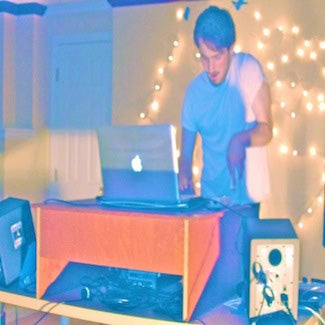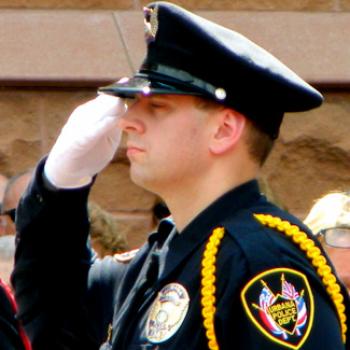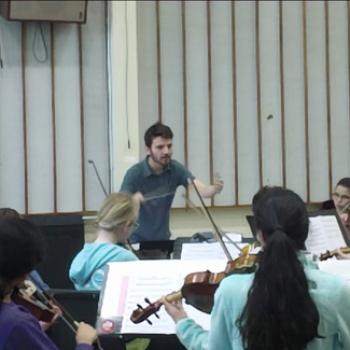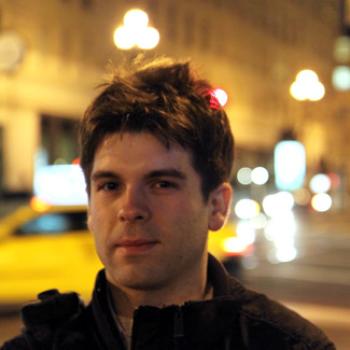On Oberlin’s inclusive music scene
Charles Abbott ’14
“Collaboration plays a fundamental role in the community’s constant appetite for great art. This inclusivity is indicative of the communal Oberlin personality that makes it such an incredible place.”

I was a weird kid in high school. I was known for playing in an experimental noise band, The Big Trucks. Much to the chagrin of my quiet suburban community, my fellow Big Trucks and I prided ourselves on sonic, and occasionally visual, shock value. For example, all of our live sound ran through the speakers inside approximately eight old small television sets. During one of our performances, we played the infamous ’90s exercise video masterpiece Buns of Steel through each of the TVs as one person moved magnets over the back of the sets to manipulate the picture and two of us improvised on a theremin and a hacked Nintendo DS. As weird as we were, The Big Trucks attracted a contingent of like-minded local musicians that would go on to build a small fringe musical community in the suburban Boston area.
After reading so much about Oberlin, taking multiple tours, and visiting three times before arriving as a first-year double-degree TIMARA major and cinema studies major, I was aware of Oberlin’s musical and artistic academic reputation. But I still worried about how receptive the Oberlin community would be to the variety of musical styles I enjoy listening to and performing. After all, my hometown and the immediate surrounding community never quite appreciated the music of The Big Trucks, or that of my other musical endeavors. This worry promptly dissolved at the orientation concert, which had a program consisting of every department in the conservatory, including a TIMARA student playing an intense improvisation on an altered electric guitar in a packed Finney Chapel.
This was a brief introduction to the incredibly versatile and accepting musical culture I eventually became a part of. With more concerts per academic year than days in the year, I was almost overwhelmed by the variety of live music I could enjoy daily at Oberlin. I easily assimilated into this diverse culture simply by attending as many of these concerts as my schedule allowed.
But what surprised me most was that the majority of these concerts drew a large audience, regardless of who was performing or what was performed. I went to crowded jazz shows at the Cat almost as frequently as I went to packed experimental improvisations at Fairchild Chapel and sold out concerts at the ’Sco. And it’s not just conservatory students giving these concerts. I’ve seen just as many college students play the same venues with similar attendance. Some of these acts that include current college students are Jaw Jam, Wax Monsters, Peaks, Think, and Native Eloquence.
Being surrounded by other students who are not only creatively driven but also extremely supportive of one another has been inspirational to me as a student and as an artist. I feel no pressure to classify myself based on an arbitrary generic category. With such support, it has been easy for me to collaborate with artists and musicians in areas previously foreign to me. Recently, I’ve had the opportunity to work with visual artists making musically interactive installations. Working in a visual medium was an eye-opening experience that helped inform my decision to become a cinema studies major. I’ve worked with dancers creating interactive dance pieces where the dancers control the music they perform in real time. Before attending Oberlin, I never would have thought I could work with dance at all, but since April we have put on three separate dance performances and plan on at least two more in the coming semester. Working with a network of artists whose members are always eager to collaborate and learn has invaluably influenced my creativity and artistic identity.
As I’ve attended more concerts, I’ve met and befriended more performers, which has allowed me to become increasingly engaged with the Oberlin music community. In turn, all my previous expectations of what a musical community can be have been surpassed. At Oberlin, everyone is welcomed and encouraged to attend every concert. All types of music are given serious attention and respect regardless of genre or style. Collaboration plays a fundamental role in the community’s constant appetite for great art. This inclusivity is indicative of the communal Oberlin personality that makes it such an incredible place. As Obies, we are adventurous, open-minded, quirky, and most importantly, supportive of one another.
As an artist and a student, Oberlin has been an inspirational environment where learning, listening, and performing has cultivated a creativity within myself I never imagined possible.
Tags:
You may also like

On musical training and non-musical careers
“I hadn’t been in law enforcement for long before I realized that many of the same characteristics of police work are similar to playing in a jazz group.”
Matt Rivers ’04

On conducting a youth orchestra
“Music is a living art, not to be kept in the glass cases of history museums...I can help foster that kind of energy and excitement about performing in another generation of musicians.”
Maurice Cohn ’17

On skills learned in the Conservatory
“In [performance], we must take all of the experience and ability we have attained through our own development and integrate it with that of others... an exercise in fluid, nonhierarchical leadership...
Michael Vito ’04